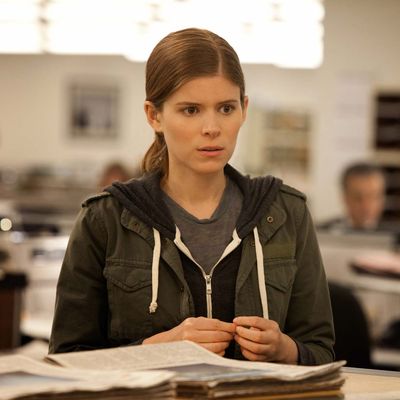
A few months ago, I was sitting at a hotel in Huntington Beach, California, typing notes on my laptop, when two teenagers came up to me and started asking me questions. What was I doing there? They wanted to know. I told them I was visiting on a work assignment for ESPN The Magazine; I was there to interview a football player for a profile I was writing.
“What did you do with him?” one of them asked. Before I could answer, the other one did for me: “She had sex with him!” he said, cracking himself up.
How could I be offended? Consider his impression of what I do for a living, based on recent representations in popular culture: There’s Nightcrawler, in which a deeply cynical newswoman played by Rene Russo is held sexual hostage by her Scorsesean psycho-villain freelancer, Jake Gyllenhaal.
There’s House of Cards, which stars two women reporters who brag of their willingness to “suck, screw, and jerk anything that moved just to get a story,” before a very unwilling source shoves one off a subway platform and forces the other out of the profession.
In cinema’s first few decades, women reporters were spunky and smart romantic foils — Hildy Johnson in His Girl Friday; Lois Lane in the Superman franchise. Then, in the ’70s and ’80s, television gave us two women journalists — still spunky but way more independent — that we could root for: Mary Tyler Moore and Murphy Brown. But sometime in the last 20 years, we became slutty ambition monsters.
Before House of Cards, there was Thank You for Smoking, a movie about a young reporter who seduces an ethically challenged tobacco lobbyist and then blows up his spot by publishing an exposé about it. Justice is served (I guess?) when the reporter is exposed for her slutty ways and reduced to the role of local weather girl.
Even the girl-reporter rom-coms like Mr. Deeds and How to Lose a Guy in 10 Days, with their happy endings, begin with the reporter attempting to seduce a guy for a story. At least Carrie Bradshaw, the most popular fictional lady journalist of the last 20 years, was supposed to be writing about her love life.
In the tradition of those romantic comedies comes Chris Rock’s new movie, Top Five. In it, Rosario Dawson plays Chelsea Brown, a New York Times reporter assigned to profile a frustrated actor played by Chris Rock, who’s struggling to reinvent himself as a serious actor after a number of comedic roles. Romance develops, plot twists happen, and if Dawson’s character has any sense of journalistic ethics, viewers never know it — which is why some women journalists, not surprisingly, didn’t love the movie.
“Memo to Hollywood: Female Journalists Don’t Sleep With Their Subjects,” Elisabeth Donnelly wrote for Flavorwire in response. Jen Yamato, a reporter for Deadline Hollywood, shredded Dawson’s character in a series of tweets: “Manic pixie dream journalist lady-slash-love interest who flirts her way behind unsuspecting man’s defensive lines, gross,” she wrote. “Said working class journo lady/single mother/sexy bisexual plays Cinderella to rich hero’s flawed ‘prince.’” She was not alone in this assessment.
Before you say, “Sometimes a movie is just a movie!” as, maybe not coincidentally, Dawson’s character does in the opening scene of the film, know that there’s a good reason why women journalists are annoyed by the depictions of women in journalism. While the practice of sleeping with our sources is not remotely universal or even widespread, what is ubiquitous is the expectation that women reporters behave like their movie-character counterparts, which can make reporting while female into a psychosexual ordeal. When I asked my fellow lady reporters about it last year, they told me so many stories: of the married K-Street type whose eyeball invariably wandered to one colleague’s cleavage during meetings; of the member of Congress who tracked down a reporter’s cell phone to repeatedly tell her she was beautiful and invite her to go boating in his district; of the countless interpretations and misinterpretations between reporters and sources where one had professional interests the other mistook for personal ones.
Top Five is not a feminist film. It’s a film in which prostitutes cry rape when they don’t get paid and strippers are used as comedic props. But Chris Rock’s movie represents something of a small turning point in the evolution of depictions of women journalists on film, because in this movie — which is funny and trenchant on race and politics if not women or gay people — Dawson’s character is at the very least interesting, and, perhaps more important, she’s an intellectual equal. A former teen mom who moonlights in photography and carries hot sauce in her purse, she can actually hold a conversation with Chris Rock on whether James Earl Ray was influenced by the racial subtext of Planet of the Apes.
She is a character built on the traits of real women you know, or women you’d like to know. She is unscrupulous. But she exists in an era where only 6 percent of people rate the media as “very trustworthy.” Surely the profession brought on some of that hatred itself. But some of it must also have to do with Hollywood, which, by the way, can’t seem to get male reporters right either. As Stephen Marche wrote, they’re invariably sinners or saints. We don’t need movies lionizing us as saints. But would it kill Hollywood to give us one grown-up Rory Gilmore?





























